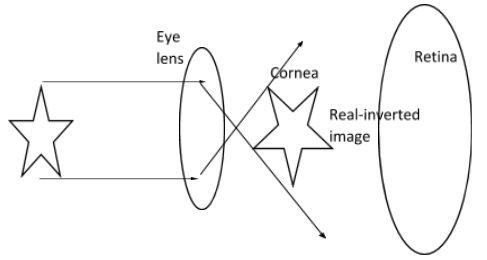
What defect does the following people suffer from?
A).Whose near point is more than 25 cm.
B).Whose far point is less than infinity.
Answer
570.3k+ views
Hint: The near point of a normal and healthy human eye is 25 cm. Similarly, a healthy eye should be able to see the things at a far distance, referred to as infinity perfectly. Any compromise to these conditions is formed as a result of a defect which can be taken care of with lenses in most cases.
Complete answer:
A healthy human eye acts as a self-allocating convex lens. The ciliary muscles are strong enough to contract and relax which helps in the adjustment of the aperture and focal point of the eye lens. The iris is a lid which controls the entry of light into the eyes.
Any light falling on the eye lens should focus on the cornea which forms a real focussed image on the retina as shown in the figure.

The defects of the human eye is the situation in which the eye lens becomes inefficient to focus on the cornea and form a clear image in the retina. There are two main types of defects. They are:
A).Myopia or short-sightedness: In this defect, as the name suggests, only allows clear vision of objects which are near to the observer. Also, the near-point of vision reduces from 25 cm to much lesser values. A concave lens of proper focal length can correct the vision. As shown in the figure, the image is formed ahead of the retina.

B).Hypermetropia or long-sightedness: In this defect cannot see objects near to the observer. The elongation of the eyeball resulting in longer focal length results in this condition. As shown in the figure below, the image is formed beyond the retina.

Let us now consider the defects described in the question.
A).It is the condition of hypermetropia.
B).It is a condition of Myopia.
Note:
There are situations when a person suffers from both the defects at old age especially due to the weakening of ciliary muscles. A progressive lens which has different focus at different points on the lens are used for the correction of this.
Hypermetropia can be corrected with a convex lens.
Complete answer:
A healthy human eye acts as a self-allocating convex lens. The ciliary muscles are strong enough to contract and relax which helps in the adjustment of the aperture and focal point of the eye lens. The iris is a lid which controls the entry of light into the eyes.
Any light falling on the eye lens should focus on the cornea which forms a real focussed image on the retina as shown in the figure.

The defects of the human eye is the situation in which the eye lens becomes inefficient to focus on the cornea and form a clear image in the retina. There are two main types of defects. They are:
A).Myopia or short-sightedness: In this defect, as the name suggests, only allows clear vision of objects which are near to the observer. Also, the near-point of vision reduces from 25 cm to much lesser values. A concave lens of proper focal length can correct the vision. As shown in the figure, the image is formed ahead of the retina.

B).Hypermetropia or long-sightedness: In this defect cannot see objects near to the observer. The elongation of the eyeball resulting in longer focal length results in this condition. As shown in the figure below, the image is formed beyond the retina.

Let us now consider the defects described in the question.
A).It is the condition of hypermetropia.
B).It is a condition of Myopia.
Note:
There are situations when a person suffers from both the defects at old age especially due to the weakening of ciliary muscles. A progressive lens which has different focus at different points on the lens are used for the correction of this.
Hypermetropia can be corrected with a convex lens.
Recently Updated Pages
Master Class 12 English: Engaging Questions & Answers for Success

Master Class 12 Business Studies: Engaging Questions & Answers for Success

Master Class 12 Economics: Engaging Questions & Answers for Success

Master Class 12 Social Science: Engaging Questions & Answers for Success

Master Class 12 Maths: Engaging Questions & Answers for Success

Master Class 12 Chemistry: Engaging Questions & Answers for Success

Trending doubts
What are the major means of transport Explain each class 12 social science CBSE

Which are the Top 10 Largest Countries of the World?

Draw a labelled sketch of the human eye class 12 physics CBSE

Explain sex determination in humans with line diag class 12 biology CBSE

The pH of the pancreatic juice is A 64 B 86 C 120 D class 12 biology CBSE

Explain sex determination in humans with the help of class 12 biology CBSE




